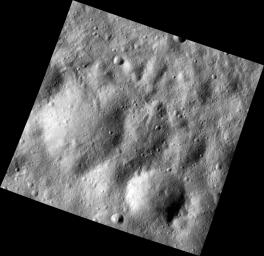
|
Buried Craters on Vesta
- Click the image above for a larger view
- Full-Res JPEG (1446 x 1403) (241.9 kB)
- Full-Res TIFF (1446 x 1403) (2.0 MB)
Caption:
This image, one of the first obtained by NASA's Dawn spacecraft in its low altitude mapping orbit, shows many buried craters located within the equatorial trough region of the giant asteroid Vesta. It is in an area that bears traces of the material thrown out by the impact that created the Rheasilvia basin in the asteroid's south polar region. Also visible are lineated features in a variety of shapes and sizes.
The image, taken by Dawn's framing camera, is centered around minus 15 degrees latitude and 50 degrees longitude. It was obtained on Dec. 13, 2011, at an altitude of 117 miles (189 kilometers). The image covers an area 11 miles by 11 miles (18 kilometers by 18 kilometers).
Background Info:
The Dawn mission to Vesta and Ceres is managed by NASA's Jet Propulsion Laboratory, a division of the California Institute of Technology in Pasadena, for NASA's Science Mission Directorate, Washington. UCLA is responsible for overall Dawn mission science. The Dawn framing cameras have been developed and built under the leadership of the Max Planck Institute for Solar System Research, Katlenburg-Lindau, Germany, with significant contributions by DLR German Aerospace Center, Institute of Planetary Research, Berlin, and in coordination with the Institute of Computer and Communication Network Engineering, Braunschweig. The framing camera project is funded by the Max Planck Society, DLR, and NASA/JPL.
More information about the Dawn mission is online at http://www.nasa.gov/dawn and http://dawn.jpl.nasa.gov .
Cataloging Keywords:
| Name | Value | Additional Values |
|---|---|---|
| Target | 4 Vesta | |
| System | Main Belt | |
| Target Type | Asteroid | |
| Mission | Dawn | |
| Instrument Host | Dawn | |
| Host Type | Orbiter | |
| Instrument | Framing Camera (FC) | |
| Detector | ||
| Extra Keywords | Crater, Grayscale, Impact | |
| Acquisition Date | ||
| Release Date | 2011-12-21 | |
| Date in Caption | 2011-12-13 | |
| Image Credit | NASA/JPL-Caltech/UCLA/MPS/DLR/IDA | |
| Source | photojournal.jpl.nasa.gov/catalog/PIA15223 | |
| Identifier | PIA15223 | |
